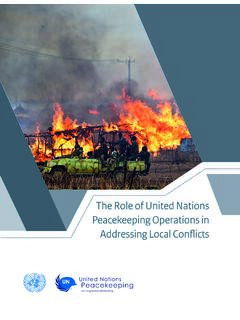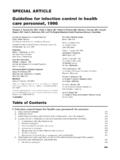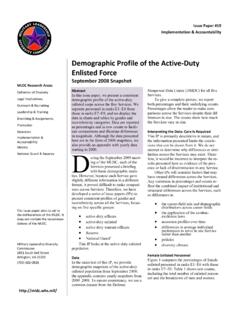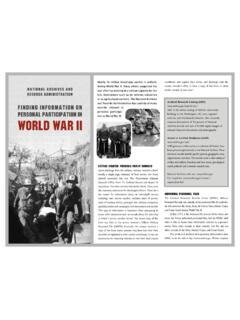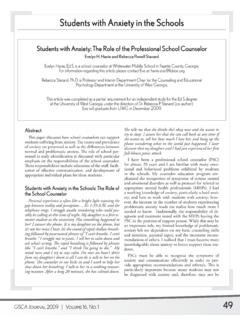Transcription of Principles and Guidelines - United Nations Peacekeeping
1 2008 Over the past six decades, United Nations Peacekeeping has evolved into a complex, global undertaking. During this time, the conduct of United Nations Peacekeeping operations has been guided by a largely unwritten body of Principles and informed by the experiences of the many thousands of men and women who have served in the more than 60 operations launched since 1948. This document captures these experiences for the benefit and guidance of planners and practitioners of United Nations Peacekeeping Nations Peacekeeping OperationsPrinciples and Guidelines2008 Over the past six decades, United Nations Peacekeeping has evolved into a complex, global undertaking. During this time, conduct of United Nations Peacekeeping operations has been guided by a largely unwritten body of Principles and informed by the experiences of the many thousands of men and women who have served in the more than 60 operations launched since 1948. This document captures these experiences for the benefit and guidance of planners and practitioners of United Nations Peacekeeping Nations Peacekeeping OperationsPrinciples and GuidelinesUnited Nations Peacekeeping OperationsPrinciples and GuidelinesUnited Nations Department of Peacekeeping OperationsDepartment of Field Support2 | United Nations Peacekeeping OPERATIONS CONTENTS | 3 ContentsCreditsPeacekeeping Best Practices SectionDivision of Policy, Evaluation and TrainingDepartment of Peacekeeping OperationsUnited Nations SecretariatOne UN Plaza, New York, NY 10 017 Tel.
2 212 963 1234 Approved by Gu henno, USG/DPKOA pproved on 18 January 2008 Contact: PBPS/D-PETR eview date: January 2010 United Nations 2008. This publication enjoys copyright under Protocol 2 of the Universal Copyright Convention. Nevertheless, governmental authori-ties or Member States may freely photocopy any part of this publication for exclusive use within their training institutes. However, no portion of this publication may be reproduced for sale or mass publication without the express consent, in writing, of the Peacekeeping Best Practices Section, United Nations Department of Peacekeeping and layout: Rick Jones Jean-Marie Gu henno .. 6 Introduction Scope and Purpose of the Document .. 8 PART I: THE EVOLUTION OF United Nations PEACEKEEPINGC hapter 1 The Normative Framework for United Nations Peacekeeping Operations .. The Charter of the United Nations .. Human Rights .. International Humanitarian Law .. Security Council Mandates.
3 16 Chapter 2 The Evolving Role of United Nations Peacekeeping Operations .. The Spectrum of Peace and Security Activities .. Linkages and Grey Areas .. The Core Business of United Nations Peacekeeping Operations .. Peacebuilding Activities .. Supporting Other Actors .. 294 | United Nations Peacekeeping OPERATIONS CONTENTS | 5 Chapter 3 The Basic Principles of United Nations Peacekeeping .. Applying the Basic Principles of United Nations Peacekeeping .. Other Success Factors .. 36 Endnotes .. 41 PART II: PLANNING United Nations Peacekeeping OPERATIONSC hapter 4 Deciding to Deploy a United Nations Peacekeeping Operation .. Assessing the Options for United Nations Engagement .. Key Lessons for Planners and Decision Makers .. The Importance of Consultations with Contributing Countries .. 52 Chapter 5 Planning a United Nations Peacekeeping Operation .. The Integrated Approach .. The Integrated Mission Planning Process (IMPP) .. 54 Endnotes.
4 57 PART III: THE ART OF SUCCESSFUL MANDATE IMPLEMENTATIONC hapter 6 Deployment and Start-Up of United Nations Peacekeeping Operations .. Typical Phases of Deployment .. The Mission Start-Up Process .. Managing the Mission Start-Up Process .. 64 Chapter 7 Managing United Nations Peacekeeping Operations .. The Relationship between Headquarters and the Field .. The Challenge of Mission Integration and Coordination .. 69 Chapter 8 Supporting and Sustaining United Nations Peacekeeping Operations .. United Nations Logistics and Administration .. Human Resource Management .. Security of Personnel .. 79 Chapter 9 Maintaining Support for the Mission .. Managing Mission Impact .. Communications and Outreach .. 92 Chapter 10 Transition and Exit .. Partnerships and Transition Planning .. Hand-Over and Withdrawal .. 86 Endnotes .. 91 Annex 1 United Nations Peacekeeping Doctrine Framework .. 92 Annex 2 Selected Glossary of Acronyms and Terms .. 946 | United Nations Peacekeeping OPERATIONS FOREWORD | 7 Jean-Marie Gu hennoForewordOver the past sixty years, United Nations Peacekeeping has evolved into one of the main tools used by the international community to manage com-plex crises that pose a threat to international peace and security.
5 Since the beginning of the new millennium, the number of military, police and civil-ian personnel deployed in United Nations Peacekeeping operations around the world has reached unprecedented levels. Not only has United Nations Peacekeeping grown in size but it has become increasingly complex. Beyond simply monitoring cease-fires, today s multi-dimensional Peacekeeping oper-ations are called upon to facilitate the political process through the promo-tion of national dialogue and reconciliation, protect civilians, assist in the disarmament, demobilization and reintegration of combatants, support the organization of elections, protect and promote human rights, and assist in restoring the rule of order to meet the challenges posed by the unprecedented scale and scope of today s missions, the United Nations Department of Peacekeeping Opera-tions (DPKO) and the Department of Field Support (DFS) have embarked on a major reform effort, Peace Operations 2010, aimed at strengthening and professionalizing the planning, management and conduct of United Nations Peacekeeping operations.
6 A key objective of this ongoing reform process is to ensure that the growing numbers of United Nations Peacekeeping per-sonnel deployed in the field, as well as those serving at Headquarters, have access to clear, authoritative guidance on the multitude of tasks they are required to present publication, which has been developed in close consultation with field missions, Member States, United Nations system partners and other key stakeholders, represents the first attempt in over a decade to codify the major lessons learned from the past six decades of United Nations peace-keeping experience. It is intended to help practitioners better understand the basic Principles and concepts underpinning the conduct of contemporary United Nations Peacekeeping operations as well as their inherent strengths and would like to express my gratitude to all those who have contributed to the development of this key guidance document, which will continue to be reviewed and updated in the coming years as United Nations Peacekeeping evolves and new lessons are learnt.
7 Jean-Marie Gu hennoUnder-Secretary-General for Peacekeeping Operations March 2008 8 | United Nations Peacekeeping OPERATIONS INTRODUCTION | 9sustainable peace in countries emerging from conflict. It identifies the com-parative advantages and limitations of United Nations Peacekeeping opera-tions as a conflict management tool, and explains the basic Principles that should guide their planning and conduct. In doing so, it reflects the primary lessons learned during the past sixty years of United Nations peacekeep-ing. It draws on landmark reports of the Secretary-General and legislative responses to these reports, as well as relevant resolutions and statements of the principal organs of the United Nations . The present document is an internal DPKO/DFS publication. It sits at the highest-level of the current doctrine framework for United Nations peace-keeping. Any subordinate directives, Guidelines , standard operating proce-dures, manuals and training materials issued by DPKO/DFS should conform to the Principles and concepts referred to in this guidance document.
8 The document is intended to serve as a guide for all United Nations per-sonnel serving in the field and at United Nations Headquarters, as well as an introduction to those who are new to United Nations Peacekeeping . Although it is intended to help guide the planning and conduct of United Nations Peacekeeping operations, its specific application will require judgement and will vary according to the situation on the ground. Peacekeeping practi-tioners in the field are often faced with a confusing and contradictory set of imperatives and pressures. This document is unable to resolve many of these issues; indeed, some have no clear, prescribed answers. Instead, it pro-vides a handrail to assist planners and practitioners manoeuvre through the complexities of contemporary United Nations Peacekeeping document reflects the multi-dimensional nature of contemporary United Nations Peacekeeping operations, which are normally led in the field by a senior United Nations political figure.
9 It does not seek to override the na-tional military doctrines of individual Member States participating in these operations and it does not address any military tactics, techniques and procedures (TTPs), which remain the prerogative of individual Member States. It is, nonetheless, intended to support civilian, police and military Over the past six decades, United Nations Peacekeeping has evolved into a complex, global undertaking. During this time, the conduct of United Nations Peacekeeping operations has been guided by a largely unwritten body of Principles and informed by the experiences of the many thousands of men and women who have served in the more than 60 operations launched since 1948. This document captures these experiences for the benefit and guidance of planners and practitioners of United Nations Peacekeeping operations. The spectrum of contemporary peace operations has become increasingly broad and includes both United Nations led peace operations, as well as those conducted by other actors, normally with the authorization of the Security Council.
10 This guidance document focuses on only one element of that spectrum: United Nations -led Peacekeeping operations, authorized by the Security Council, conducted under the direction of the United Nations Secretary-General, and planned, managed, directed and supported by the United Nations Department of Peacekeeping Operations (DPKO) and the Department of Field Support (DFS). The specific focus of this document rec-ognizes the need for a clearer articulation of the doctrinal foundations of United Nations Peacekeeping operations, in light of the new challenges posed by the shifting nature of conflict, from inter-state to intra-state conflicts. The present document aims to define the nature, scope and core business of contemporary United Nations Peacekeeping operations, which are usu-ally deployed as one part of a much broader international effort to build a Scope and Purpose of the DocumentIntroduction10 | United Nations Peacekeeping OPERATIONS INTRODUCTION | 11 PART IThe Evolution of United Nations Peacekeeping OperationsThe Charter of the United Nations was signed, in San Francisco, on 26 June 1945 and is the foundation docu-ment for all the United Nations work.




